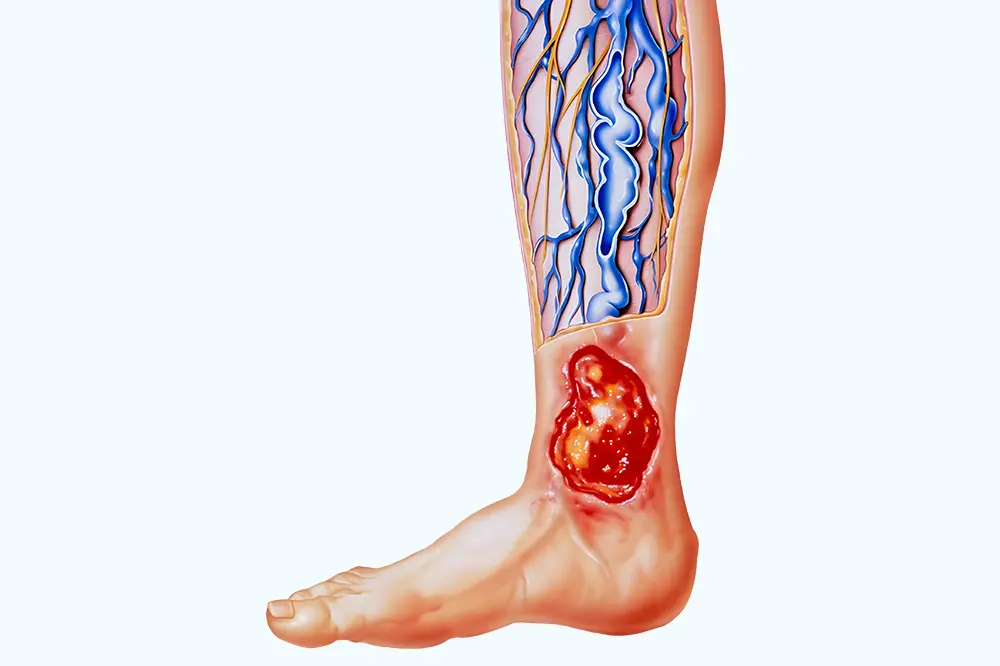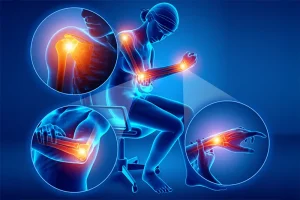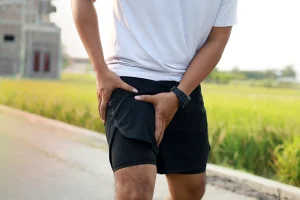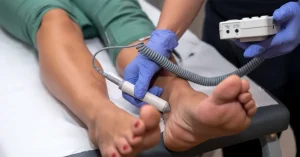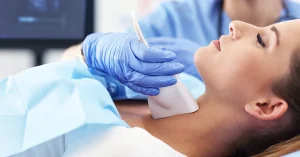Venous leg ulcer is a serious medical condition that affects many people worldwide. It is not merely a cosmetic issue but a significant health concern that can lead to serious complications if left untreated. In this article, we will explain in detail what a venous leg ulcer is, its causes, symptoms, diagnostic methods, treatment options, and ways to prevent this condition. Understanding this condition is essential for protecting your health and quality of life.
Venous Leg Ulcer
A venous leg ulcer is a serious medical condition that affects many people worldwide. It is more than a cosmetic issue and can cause severe complications if left untreated. This article explains what a venous leg ulcer is, its causes, symptoms, diagnostic methods, treatment options, and prevention strategies. Understanding this condition is the first step in protecting your health.
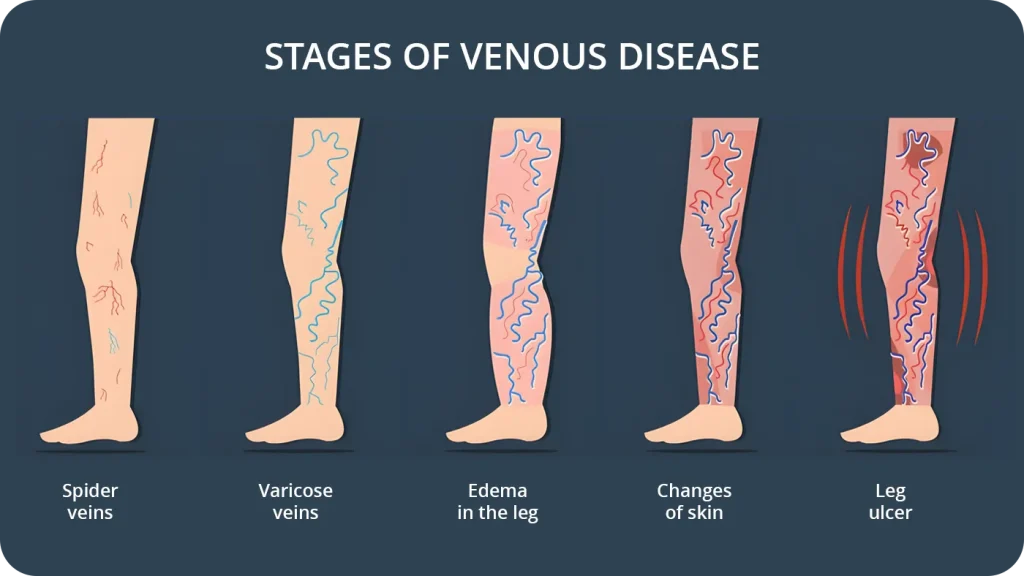
Causes And Risk Factors Of Venous Leg Ulcer
Chronic Venous Insufficiency
Chronic venous insufficiency is the main cause of venous leg ulcers. When veins fail to return blood effectively to the heart, blood pools in the legs, increasing venous pressure and damaging the skin.
Risk Factors
- Age: Aging weakens vein valves, raising the risk of venous insufficiency.
- Gender: Women are more likely to develop venous leg ulcers due to hormonal changes.
- Obesity: Excess body weight puts more pressure on leg veins.
- Sedentary lifestyle: Lack of movement slows blood circulation.
- Smoking: Smoking damages blood vessels and circulation.
- Dietary habits: Diets low in fiber and high in salt can lead to fluid retention and swelling, adding pressure to the veins.
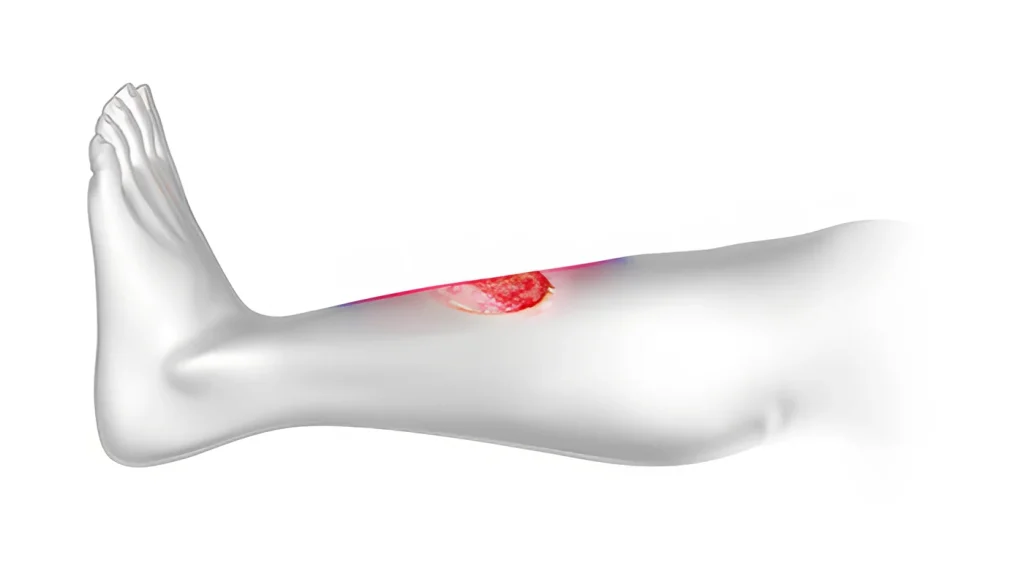
Venous Leg Ulcer Symptoms
Common Signs
- Open sore with a dark or reddish appearance
- Localized pain
- Swelling, especially near the ankle
- Inflammation and tenderness around the ulcer
- Thin, shiny skin near the wound
- Burning sensation or tingling
Diagnostic Methods For Venous Ulcers
To diagnose a venous leg ulcer, your doctor will examine the affected area and evaluate your symptoms. Additional tests, like a Doppler ultrasound, help check blood flow in the veins and assess vein function.
Treatment For Infected Venous Leg Ulcer
Treatment for an infected ulcer includes medications, wound care, and sometimes surgery. Prompt treatment reduces the risk of complications.
Medications For Venous Leg Ulcers
Doctors often prescribe venotonic medications to improve circulation and reduce blood pooling. If an infection is present, antibiotics such as Amoxicillin with Clavulanic Acid, Ciprofloxacin, or Levofloxacin may be recommended.
Always consult your doctor for a proper diagnosis and prescription. Avoid self-medicating to prevent complications.
Local Treatment
Local care involves cleaning the wound with saline solution and applying sterile dressings. Hydrocolloid dressings are commonly used because they absorb excess fluid and protect against infection.
Natural And Alternative Remedies
- Creams and ointments: Corticosteroid-based or moisturizing creams may help reduce inflammation and discomfort.
- Natural products: In some cases, natural remedies may be used but always under medical supervision.
Surgical Treatment
For severe or non-healing ulcers, vascular surgery may be needed to restore blood flow and remove problematic veins.
Prevention Of Venous Leg Ulcers
Healthy Lifestyle
Maintaining a healthy weight and an active lifestyle are essential to prevent venous leg ulcers. Regular walking and leg exercises support healthy blood flow.
Diet For Venous Ulcers
To help manage venous ulcers:
- Eat fiber-rich foods like vegetables, fruits, and whole grains.
- Limit salty foods to reduce water retention.
- Stay hydrated by drinking enough water daily.
- Include antioxidant-rich foods like berries.
- Avoid processed foods high in sugar and saturated fats.
Skin Care
Keep the skin moisturized and protected from injuries. Wearing compression stockings can help maintain healthy vein pressure.
Importance Of Ongoing Care
Good wound hygiene and following medical instructions are crucial to prevent infections and ensure complete healing. Always seek guidance from a specialist for the best results.
Importance Of Medical Consultation
When To See A Doctor
Seek medical advice if you notice persistent pain, swelling, or open sores on your legs. Early treatment helps prevent serious complications.
The Doctor’s Role
A venous leg ulcer is a serious condition that needs proper care and treatment. Recognizing causes and symptoms and getting timely medical help are key to managing this condition. By staying active, following a healthy diet, and caring for your skin, you can prevent venous leg ulcers and improve your quality of life. Schedule a consultation and see how we can help.
Medical Consultant: Dr. René Milleret
References:
- Management of leg ulcers Postgrad Med J. 2000 Nov; 76(901): 674–682.
doi: 10.1136/pmj.76.901.674 - The impact of a new intervention for venous leg ulcers: A within-patient controlled trial Int Wound J 2023 Aug;20(6):2260-2268. doi: 10.1111/iwj.14107. Epub 2023 Feb 13.
Frequently asked questions
What is a leg ulcer?
A leg ulcer is an open wound on the leg, usually between the knee and ankle, caused by circulation problems such as chronic venous insufficiency or atherosclerosis.
How long does it take for a venous leg ulcer to heal?
Healing time can range from a few weeks to several months, depending on the severity and treatment effectiveness.
What is a skin ulcer?
A skin ulcer is an open sore caused by poor circulation or constant pressure. It heals slowly and is prone to infection.

